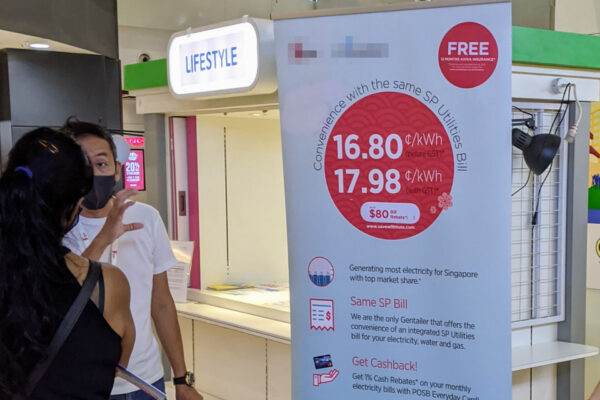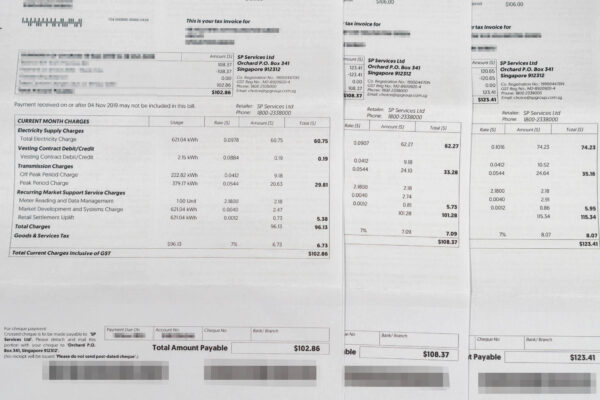
Even though competition in the retail electricity market has opened since late 2018, many people are still unware of new electricity options available to them. What are they about? What should they choose? Are they better than the incumbent? Here’s my October 2020 update on the situation.
Whenever I hear that someone is still paying the regulated electricity tariffs, there are usually two reasons. The first is that they are simply unaware that there are other options available. The other is that while they know of the new retail options, they are overwhelmed by the choices, and not knowing how and what to choose, end up staying put as a “safe choice”.
I’ve already posted twice on this topic, the most recent just under a year ago. I’ve been procrastinating about yet another post, despite several requests from my readers, because there isn’t anything substantial to add. My views from before are largely unchanged, and my recommendations are the same.
However, greater public awareness seems to be needed. This is especially when (not surprisingly) you hear roadshow promotors hard-selling their retail plans without full disclosure of pertinent facts.

This will be a slightly longish post. The TL;DR version is simple. If you are still paying the regulated SP Services electricity tariff, almost any other new retail option is better. My recommendation, however, is to go with SP Services’ Wholesale Electricity Plan.
Go with SP Services, you ask? Isn’t that the evil company that’s overcharging us? No, no. First, the regulated tariff isn’t determined by them. Secondly, the wholesale electricity plan is entirely different. Get the fuller picture below.
Background on OEM
Singapore opened up the retail electricity market to freer competition in late 2018. The governing authority, Energy Market Authority (EMA), calls this the Open Electricity Market, or OEM. Sounds complicated? Without going into details, here’s the gist of it:
- There is still one single power grid, the electricity distribution system that actually connects to your home and delivers electricity to you. This distribution system is owned by SP PowerAssets and managed by SP PowerGrid, both owned by SP Group (previously simply known as “Singapore Power).
- There are several power generation companies that plug into the grid. You may be familiar with names like Senoko Energy, SembCorp Cogen, and PowerSeraya.
- SP Services, which is also owned by SP Group, is the front that faces retail customers. Previously, and perhaps still currently, you get your electricity bill from them. Your gas and water bill comes from SP Services.
- In the OEM model, you can switch to buy electricity from an Electricity Retailer, who doesn’t have to be, and usually isn’t, a power generation company itself. The retailer is like a go-between for the money part of the business; electricity doesn’t actually flow through them.
If you don’t do anything, then you’ll just pay the regulated tariff, determined by EMA, to SP Services, who then pays the power generation companies.
New Electricity Retailers
The new Electricity Retailers bring new electricity plans to to residential consumers with promises of lower prices than the regulated tariff. This is mostly true, especially when their plan fixes a discount rate from the regulated tariff. I.e. you will always be paying lower than the regulated electricity tariff.
Ohm, one of the Electricity Retailer, for example, has offers the Ohm Discount plan that presently fixes a 22% discount off the regulated electricity tariff on a 6-month contract. With this plan, you always pay less than the regulated electricity tariff.
This is a good plan. No brainer, right?
Maybe. But what if you could pay even less? Using Ohm again as example, also offers a Fixed Ohm plan that presently charges a fixed 16.85 cents per kWh on a 6 month contract. Given the present tariff at 22.93 cents per kWh, the 22% discount on the previous Ohm Discount plan works out to 17.89 cents per kWh. This is more than the Fixed Ohm price at present!
(For simplicity, all prices in this post, unless otherwise stated, is inclusive of GST.)
Now, maybe you begin to see why theses plans get complicated. The Fixed Ohm plan is good, compared to the Ohm Discount plan, provided the regulated electricity tariff doesn’t drop too much. If you are expecting electricity prices to go up, then the Fixed Ohm plan is good.
Let me offer another example. Geneco, which is part of power generation company PowerSeraya, offers a 24-month fixed discount plan of 23% off the regulated electricity tariff, and a 6-month fixed price plan at 16.79 cents per kWh.
EMA provides an online comparison tool to help you compare between different plans from different Electricity Retailers. Have a go at it.
If you like to crunch numbers, you can get the historical regulated electricity tariffs from SP Group. While fixed price plans carry some risk that you may may more if the regulated electricity tariff crashes, this is highly unlikely. The regulated electricity tariff has never gone below 16.85 cents per kWh.
Either way, fixed price or fixed discount, you should always be better off than the regulated electricity tariff.
SP Wholesale Electricity Plan
What is not evident to most residential consumers is that SP Services can also sell electricity at a different price from the regulated electricity tariff. This other price is available under their Wholesale Electricity Plan.
The idea here is that you pay the actual wholesale market rate. This rate fluctuates on a half-hourly basis, depending on supply and demand (and several other factors). This is akin to changing foreign currency at the interbank currency exchange rate, instead of the marked up prices you’ll get at a money exchanger.
The wholesale market rate is the true cost of electricity being traded in the energy market.
I should mention that SP Services isn’t the only company selling electricity based on a wholesale rate. However, the other retailers, such as Ohm, on their Market Ohm plan, levies a $10.70 per month surcharge. You would basically pay the same, less that $10.70 per month surcharge, if you go with SP Service’s Wholesale Electricity Plan.
The Wholesale Electricity Plan looks daunting because there are many price components. The basic component, the Wholesale Electricity Price (WEP), is the one one that fluctuates on a half-hourly basis. However, there are many other cost components, including the following that are regulated by EMA:
- Transmission charges: two different rates, 4.12 cents per kWh for off-peak hours and 5.44 cents per kWh for peak hours
- Meter Reading and Data Management charge: $2.18 per meter
- Market Development and Systems charge: 0.38 cents per kWh
- Retail Settlement Uplift: 0.12 cents per kWh
While the above costs are known up-front, there is another component below that varies from month to month:
- Vesting Contract Debit/Credit: Variable, determined after the month of consumption
Vesting Contracts are bilateral agreements between power generation companies and the Market Support Services Licensee (presently SP Services) that mandate a specified amount of electricity to be hedged at a specified price. This is done in order to mitigate against larger power generation companies influencing market prices by withholding supplies. This figure is relatively small, so despite how an “unknown variable” sounds worrisome, the impact to your bill is minimal.
Complicated? It may help to look at some real numbers of actual costs. Seeing that costs vary by time and usage pattern, let me share with you the actual effective kWh electricity rate I have been paying from month to month for the last 12 months.
| Month/Year | Effective Cents / kWh |
| Oct 2019 | 16.56 |
| Nov 2019 | 15.37 |
| Dec 2019 | 14.22 |
| Jan 2020 | 14.80 |
| Feb 2020 | 15.84 |
| Mar 2020 | 14.54 |
| Apr 2020 | 12.97 |
| May 2020 | 11.82 |
| Jun 2020 | 12.16 |
| Jul 2020 | 12.10 |
| Aug 2020 | 13.56 |
| Sep 2020 | 13.52 |
You see that the prices can fluctuate a fair bit, but they have never crossed above the lowest of any fixed price plans from new Electricity Retailers. In fact, my full-year average effective electricity rate is just 13.83 cents per kWh. This is a cool 40% discount from the present regulated electricity tariff, and 18% lower than Ohm’s Fixed Ohm plan.
My actual dollar savings are quite significant. Compared with the regulated electricity tariff, and taking into account their actual quarterly rates since Oct 2019, the Wholesale Electricity Plan helped me save almost $900! Comparing with Ohm’s Ohm Discount plan, I would save $430, and compared with Fixed Ohm plan, I still save about $270!

I mentioned earlier that Ohm also offers a plan pegged to wholesale electricity price. However, do remember they levy a $10 per month surcharge. Hence, you still end up paying $120 more than SP Services’ Wholesale Electricity Plan.
Other Bundles and Promotional Discounts
The new Electricity Retailers can offer various kinds of bundle offers and promotional discounts. Geneco, for example, presently offers a $50 bill rebate.
SP Services, unfortunately, is forbidden by EMA from offering bundles and promotions. Their Wholesale Electricity Plan is just what it is.
This makes pricing more complicated and harder to make simple comparisons.
The question you should ask, I suppose, is if the value you get out of those bundle offers and promotional discounts from other Electricity Retailers exceed the savings from SP Services’ Wholesale Electricity Plan? Geneco’s $50 bill rebate, for example, is far less so.
Although SP Services themselves can’t offer you discounts, do note that you still get to enjoy discounts that are offered by others. For example, if you pay your SP Services electricity bill with the UOB ONE card, you may be able to get up to an additional 5% rebate. You can also get a $5 rebate for setting up recurring payment.
Be Ready for Price Fluctuations
The nature of the market pricing means that prices can and will fluctuate. You can actually use this to your advantage. For example, change your electricity consumption pattern to match higher usage to times of the day when electricity prices tend to be lower.
Better yet, you can even watch the forecasted prices, and match your consumption accordingly. For example, see that prices are bottoming out for the day, and turn on your storage water heater at that time for your bath? I suppose this is more theory than practice, since I don’t think many people will go to this extent to lower their electricity bill. However, this is possible.
You can get the forecasted Uniform Singapore Energy Price up to nearly 72 half-hourly time period ahead (i.e. nearly 1.5 days).
There’s a lot of data you can get from the Energy Market Company. They’re basically the stock market for electricity prices. If you like to analyse data, it’s all there.
The Risks are Okay
SP Services’ Wholesale Electricity Plan has no contract. You can quit any time. This isn’t something you are committed for a long term, or for any term at all.
If you are extremely risk averse, and worry that the wholesale prices might just skyrocket some day, you can always go back to the regulated electricity tariff, or go with a new Electricity Retailer. You will never be worse off than the regulated electricity tariff.
Furthermore, since the regulated electricity tariffs likely also hedges against rises in electricity supply costs, you can expect that the Wholesale Electricity Prices to still work out cheaper anyway. What you may lose out on is the potential savings of having signed up on a long-term fixed price contract when prices were low.
You are also assured to always get your electricity, uninterrupted, regardless of who you buy your electricity from. As I mentioned before, you are still connected to the same power grid, which in turn, gets power from all the same power generation companies. It’s not as if buying electricity from Tuas Power, which is both an Electricity Retailer and a power generation company, will mean you suffer a blackout if there is an outage in Tuas Power’s power generation facility.
Hence, as far as reliability of electricity is concerned, you do not need to worry about the reputation, financial stability, or anything about the business of the Electricity Retailer you buy from.
In fact, you are also guaranteed uninterrupted electricity supply when you change retailers, or change plans. This is unlike the mess with changing Internet Service Providers, which sometimes entail service disruptions.
How to Switch
My recommendation is to go with SP Services’ Wholesale Electricity Plan. If you’re ready to make the switch, here’s what you need to do:
- If you are presently on the regulated tariff, just head to SP Utilities Portal and look for the option to switch to the wholesale electricity plan.
- If you are already on one of the new Electricity Retailers, you need to tell your present retailer that you want to quit and return to SP Services’ Wholesale Electricity Plan. You cannot get SP Services to “bring you back”, unlike how Electricity Retailers can “bring you over” to them; the new Electricity Retailer needs to kick out back.
It took me quite a long time to get out of Geneco (almost a month), and I’ve heard others making similar complaints. Their customer service is really atrocious. Do prepare to plan your exit ahead of time.
Even if not required, it is best to get the new smart meters (Advanced Metering Infrastructure), which records your electricity consumption in real time. This allows SP Services to bill you according to your actual half-hourly consumption. Otherwise, you will be billed based on a presumed national consumption profile, which may work for or against you. You can read more about the load profile on EMA’s Metering Options page. I suppose the smart meter will work better for you if you tend to consume more electricity during periods when the average household is presumed to use less electricity, and vice versa.
If you already have the new smart meters, good. Otherwise, there’s a small one-time fee to get it changed (presently $40 before GST). You can see your near real-time (about half-day lag) electricity consumption in the SP Utilities mobile app. You can also get more data from the web SP Utilities Portal (web). This information is definitely helpful to give you insight to your consumption patterns.
Since SP Services is your retailer, you’ll get your bills from SP Services.
Goodbye Regulated Tariffs
It is quite clear that paying at the regulated electricity tariffs just doesn’t make sense at all. The very least you should do is to go with a fixed discount plan from any new Electricity Retailer. The fixed discount assures that you are definitely saving something compared with the regulated electricity tariffs.
If you are more adventurous, SP Services’ Wholesale Electricity Plan seems to offer the greatest value. The charges may be complicated, but the numbers speak for themselves. It has the greatest savings for me, shrinking my bill by $900 in the last 12 months compared with the regulated electricity tariffs. You can’t get that much savings with any other electricity plan.
See my previous posts on this topic:
Update: How Is Wholesale Electricity Doing? (25 Sep 2021)
This month August 2021 wholesale SP rate is very high.
Yup, the price is no longer favourable from earlier this year.
The rate is even higher in Sep 2021. I’m paying almost double my average rate.
Hi,
Can share how much is the wholesale rate for Aug and sep 2021?
Hi can share 2021 monthly effective rates ?